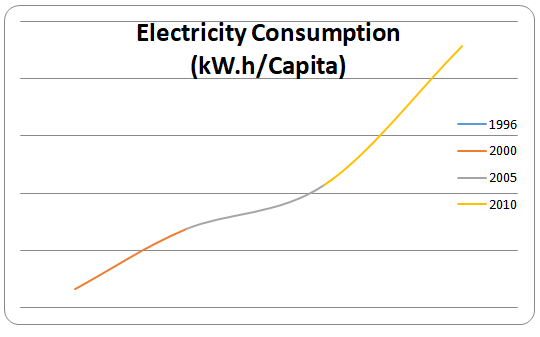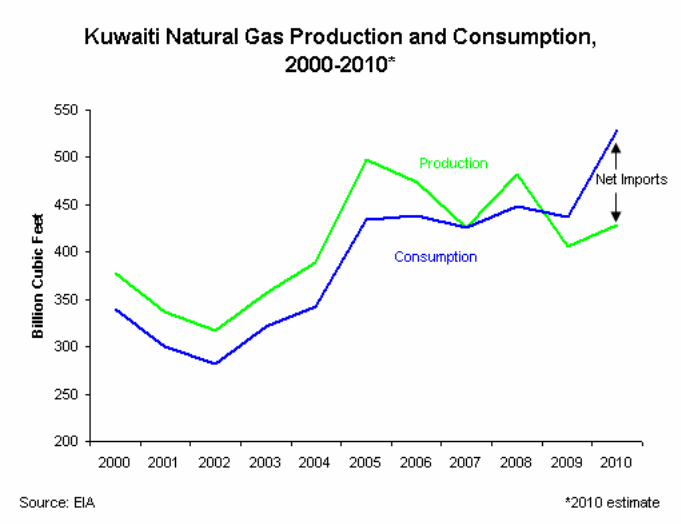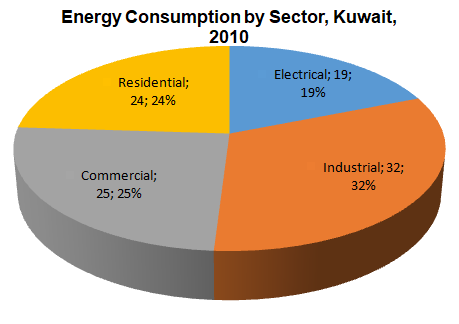Overview
Energy is very important in our daily lives and thus its production and consumption is important to us. Energy has found many uses in today’s world but the four main uses are in the electrical, industrial, commercial and residential fields. This essay is going to analyze Kuwait’s energy consumption in four main sectors.
Electrical: Kuwait electrical consumption currently stands at around 11,000MW and this is against the installed capacity of approximately 12,000MW. Demand for electricity has been on the rise and currently stands at 8%. In terms of Kilowatt hours the country consumes close to 41 billion kWh (Kilowatt Hours).
The consumption of the country per person/capita amounted to 16,285 kW.h (kilowatts per hour) in 2010 and this was a rise from 15,069 in the year 2005 (Cordesman, 2010).
Demand for electricity is set to grow to 20,000 MW per the year 2015 as energy needs grow. Kuwait does not have any hydro electric power generation plants but makes use of gas and steam generation plants. This is shown in figures 1 and 2.

Figure 1: Kuwait’s Electrical Consumption

Figure 2: Kuwait Oil Production and Consumption
Industrial: Kuwait comprises of heavy industries that make use of energy in their production. Kuwait is mainly an oil producing nation and therefore is consumes a lot of oil in production. Kuwait’s oil consumption stood at about 350, 000 barrels of oil per day in the year 2010.
This was against the production level of 3.5 million barrels of oil a day. Around 40% of Kuwait’s oil is used for industrial purposes and this amounts to around 140,000 barrels of oil a day.
Industrial use is classified as direct use of energy in production of goods and services (McElroy, 2010). Oil consumption in industries is set to drop due to the increased production of gas reserves used in electricity generation. This is shown in figure 3.
Figure 3: Kuwait Natural Gas Production and Consumption
Commercial: Kuwait’s power consumption in the commercial sector looks into how power is consumed apart from heavy industrial use. Commercial energy consumption in Kuwait can be categorized into industries involved in the production of energy.
The transport sector in Kuwait consumes around 110,000 barrels of oil which is used in air, sea and road transport (Atkinson, 2011). However, Kuwait relies heavy on gas power to produce electricity for their own industrial use.
In the year 2010, Kuwait consumed around 530 billion cubic feet of gas equating to 1.45 billion cubic feet of gas a day (International Energy Agency, 2005). Moreover, the production of natural gas is less compared to consumption of the same as outlined in figure 4. Kuwait uses natural gas to generate around 14 TWh (Terawatts per hour) in the year 2010.

Figure 4: Energy Consumption by sector, 2010.
Residential: Kuwait is a small country with a population of about 2.8 million people and most of these people rely on oil, electricity and natural gas in their everyday lives. Kuwait residents consume around 100,000 barrels of oil mainly for their vehicles and minor uses in their homes.
Due to the hot climate, Kuwaiti’s appetite for electricity has grown tremendously and thus gas consumption in the year 2010 outshot production (McElroy, 2010).
For instance the country produced 1.17 billion cubic feet of gas a day compared to 1.45 billion feet of gas consumed a day. Thus the country imported close to 270 million cubic feet of gas a day from Yemen and Oman. Figure 1 summarizes the electricity consumption per person in Kuwait.
References
Atkinson, A. (2011). The Report: Kuwait 2010. Oxford: Oxford University Press.
Cordesman, A., & Al-Rodhan, K. (2010). The Changing Dynamics of Energy in the Middle East. Boston, MA: Praeger.
International Energy Agency. (2005). World Energy Outlook 2005: Middle East and North Africa Insights. New York: International Energy Agency.
McElroy, M. (2010). Energy: perspectives, problems, and prospects. Chicago, IL: John Wiley and Sons.